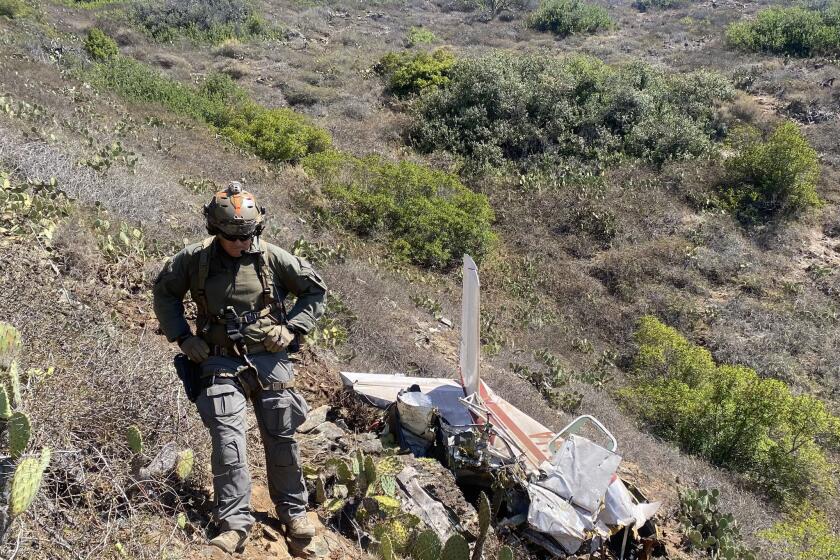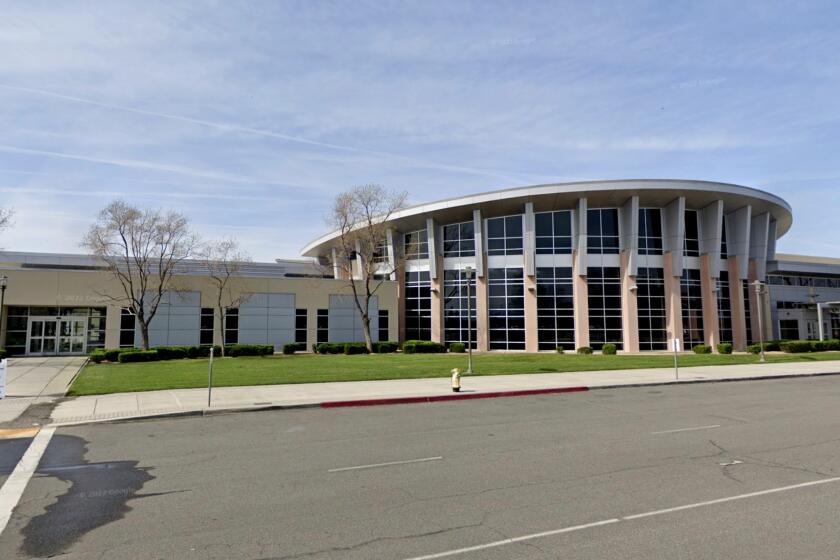Custodians of the Fast Lane : Caltrans Workers Try to Stem the Constant Flow of Dangerous Debris
Toxic waste. Piles of nails. Refrigerators. Truckloads of tomatoes. Live chickens. Even dead bodies.
“If it exists, it’s spilled on the freeway,” said Al Gallegos, a maintenance supervisor and 33-year veteran with the California Department of Transportation in Orange.
“We probably collect enough cement, sand and lumber to build a house, enough furniture to furnish it, and even some farm animals to put in the back yard.”
Orange County has 140 miles of freeway. On some days, stretches of concrete are drenched with beer, coated with ketchup and covered with blankets and newspapers.
It’s the responsibility of Gallegos and 150 Caltrans maintenance workers in the county to clean up these spills, which can cause accidents and snarl traffic for hours on Orange County’s eight freeways. It’s life in the fast lane, and one that’s never short of intrigue, surprise and danger.
Caltrans officials do not keep statistics on the number of spills, but Gallegos estimates that he and his crew, one of three maintenance units in the county, respond to about 360 calls each year to remove spilled loads from freeway lanes.
California Highway Patrol officers are the first to receive reports of spilled loads, many of them from cellular telephone users who flood the agency’s Santa Ana switchboard with about 300 traffic calls each day.
Ken Daily, a 26-year veteran, keeps a picture of his most memorable spill on a notice board in the CHP’s San Juan Capistrano office. The snapshot was taken after 800 cases of Orange Crush soda fell through the bed of a tractor trailer on southbound Interstate 5 and exploded on the freeway near Junipero Serra Road.
Daily said the spill backed up traffic for 20 miles.
“It was a huge traffic headache, not to mention the giant mess with cans exploding like little volcanoes all over the place.”
After receiving a report of a spilled load, the CHP routinely calls the Caltrans’ office in Santa Ana. A dispatcher there relays the report to Gallegos and his co-workers.
The calls come in at all hours, but most spills occur during daylight.
Sometimes it’s a load of molten sulfur, rocket fuel, toxic waste or just long splotches of gasoline or diesel fuel.
If the CHP and Caltrans suspect that a spilled load is hazardous, they shut down the freeway until the County Fire Department and a Caltrans subcontractor remove the debris, said Officer Lyle Whitten, a 26-year-veteran at the CHP office in Westminster.
But there have been instances when commuters came in contact with the toxins. When a load of toxic waste spilled five years ago on the Santa Ana Freeway in Buena Park, authorities closed the freeway for eight hours, but not before a dozen motorists--including a press photographer--walked through the ooze.
The contaminated motorists were forced to strip to their birthday suits on the freeway so that they could be hosed down by firefighters, Whitten said.
“The photographer thought he had a scoop until the firemen told him off with his clothes,” Whitten said. “I bet he has never told that story to anyone.”
Toxic spills, however, are not a daily headache for Gallegos and his men; only 23 of the 839 hazardous spills in the state last year took place on freeways in Orange County.
Instead, they must worry about the endless stream of wooden pallets, mattresses, hubcaps and blown-out tires that wind up in the lanes.
“If you don’t remove these objects, you get major accidents,” Whitten said. “Drivers instinctively swerve at any object in the road . . . run off the road or collide into each other. Spills have caused quite a few fatalities.”
Working in Caltrans’ maintenance office in Orange is like being in the eye of a hurricane. Four of the nation’s 10 most heavily traveled interchanges are in Orange County. Two of them--the “Orange Crush,” where the Orange, Santa Ana and Garden Grove freeways converge, and the interchange of the Santa Ana and Costa Mesa freeways--are in Gallegos’ district.
Trucks frequently tip over and spill their loads on these interchanges because their cargoes might have been sloppily loaded or another vehicle might have swerved in front of them, Gallegos and the CHP said.
Gallegos has learned over the years that some spills come with the seasons and holidays.
In the winter, he tells his men to expect to find dozens of camper shells, mattresses and newspapers blown off vehicles by gusty Santa Ana winds.
In the summer, they wait for calls about squished loads of fruit on the freeways: oranges, avocados, watermelons, cantaloupes.
Near Christmas and Thanksgiving, the crews retrieve clothing--gifts that have blown out of vehicles. Gallegos now owns three new Members Only jackets that he picked up from the freeway a year ago.
Sometimes, the job can have its special rewards. Only two weeks ago, a member of Gallegos’ work crew found $250 while picking up trash along the freeway. The same worker had found a few hundred dollars lying on the shoulder of the Santa Ana Freeway just a few months before, Gallegos said.
Gallegos said his men never buy tools because they find all brands of hammers, chisels, nails and screwdrivers. They frequently find purses and wallets, and occasionally, they stumble on jewelry. Diamond rings. Gold bracelets. Necklaces.
Each month, the men also recover dozens of hubcaps on the freeway which they toss in plastic barrels at the Orange yard. If they are unclaimed after two months, the hubcaps are sold for up to $1.50 each and used for employees’ lunch money.
Gallegos said his crew receives dozens of calls each week from motorists who want Caltrans workers to retrieve their lost hubcaps on the freeway. Some “tell us they are certain that their hubcaps flew out along some seven-mile stretch,” Gallegos said. “Most of the callers are the ones who own Mercedes, BMWs and Cadillacs.”
The workers don’t go looking for lost hubcaps, but they invite the callers to visit the Orange yard and see if they can find a similar one.
Cleaning debris from the freeway is like dodging bullets. Workers who step into busy freeway lanes to snare a mattress, for example, sometimes have to run for their life because that red blur in the distance may be a sports car hurtling in their direction at 100 m.p.h.
Drunks and inattentive drivers sometimes zoom through flares, beacon lights and flashing arrows and slam into Caltrans cleanup crews. In the last 15 years, three of Gallegos’ workers have been killed on the job by errant drivers. Many others have been injured.
Irate drivers who blame Caltrans for the spilled loads that result in traffic jams hurl more than profanities at the maintenance workers. Gallegos and his men are frequently pelted with ice cubes and tennis balls, soaked with soft drinks and beer and even spat on. A few years ago, one angry driver drew a pistol and riddled a parked Caltrans truck with bullets. Luckily, no one was hurt, Gallegos said.
Still, Gallegos will miss his job when he retires in the next few years.
“It can be frustrating sometimes,” he said. “But it’s never dull. You come to work and as soon as the phone (rings) you want to say: ‘Now, what is it going to be today?’ ”
Freeway Spills
Selected spills on the county’s freeways during the first five months of 1992:
Twenty-five 50-pound bags of lime: southbound Orange Freeway near Katella Avenue
20-pound buckets of chlorine and hydrochloric acid (pool-cleaning materials): southbound San Diego Freeway near Jamboree Road
Rocks and gravel: all lanes westbound Riverside Freeway at Imperial Highway
Cases of motor oil: northbound Orange Freeway at Orangewood Avenue
Four cases of nails: eastbound Riverside Freeway to northbound Orange Freeway interchange
Three 6-by-8 sheets of glass: westbound Riverside Freeway to southbound Costa Mesa Freeway interchange
100 gallons diesel fuel: northbound Orange Freeway near Ball Road
Load of fire hydrants: westbound Riverside Freeway east of Acacia Avenue
Industrial batteries: southbound Santa Ana Freeway at Magnolia Avenue
Stereos: southbound Santa Ana Freeway near Katella Avenue
Cases of Orange Crush soda: southbound Interstate 5 at Avery Parkway
Horses from trailers: westbound Riverside Freeway near Coal Canyon Road
Source: Officer Angel Johnson, California Highway Patrol, Santa Ana
More to Read
Sign up for Essential California
The most important California stories and recommendations in your inbox every morning.
You may occasionally receive promotional content from the Los Angeles Times.









